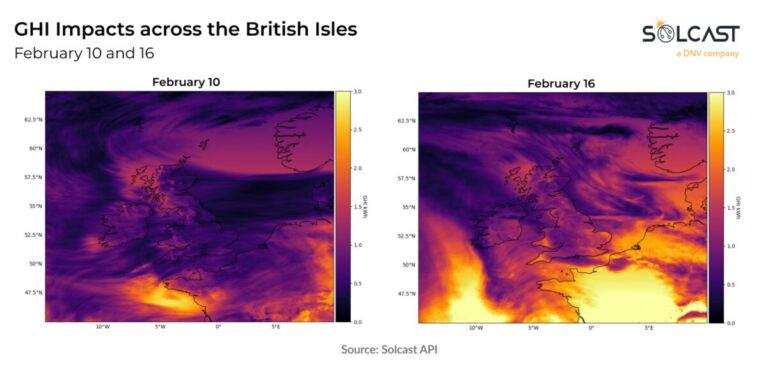In a new weekly update for PV -MagazineSolcast, a DNV company, reports that cloud-bearing weather systems dominated the British islands, which significantly reduced the irradiation in the VK and Ireland between 9 and 18 February 2025, when the sun generation in the region at least reached the lowest levels relating to capacity in at least ten years.
Cloud-bearing weather systems dominated the British islands, which significantly reduced the irradiation and solar generation in the United Kingdom and Ireland between 9 and 18 February 2025. Persistent cloud covering arrived for the first time from the east under the influence of a Scandinavian high-pressure system and followed by clouds and followed by clouds and followed by clouds and followed by clouds and followed by clouds of the Atlantic Ocean. This combination resulted in historically low PV output, in which Ireland was most seriously influenced, according to analysis using the Solcast API.
Between 9 and 18 February, Zonne generation on the British islands reached its lowest levels compared to capacity in at least ten years. Analysis of the distribution network in the UK has shown that all regions for distribution network manager, except for British energy networks
(UKPN) in Zuidoost -Engand, registered their lowest PV generation for this time of year in ten years. The UKPN region saw its second lowest February performance in the same period.
The distribution area of Northern Power Grid (NPG), which covers Noordoost -Eengand, was one of the most difficult affected, with generation by 56% compared to normal levels. Other distribution network operator areas, including Scottish Power Energy Networks (Spen), Scottish and
Southern Electricity Networks (SSSen), Electricity North West Limited Grid (ENWL) and National Grid Electricity Distribution (Nged) also saw a reductions of 30%-39%.
The first phase of long -term cloud covering was powered by an eastern stream linked to a Scandinavian high -pressure system. This set -up has channeled a low cloud on the British islands, reducing the sun’s radiation in a large part of the region. Later in the period a strong jet stream strengthened the Atlantic Atlantic Atlantic Atlantic atlantic way frontal systems that entered from the West and brought widespread cloud and rainfall. These systems suppressed radiation, in particular throughout Ireland and many parts of Great Britain, so that solar production was brought through the seasonal standards.
Some locations in Ireland and Great Britain registered their lowest solar radiation mirrors in 18 years, during the period from 9 to 18 February. For example, Dublin saw the average daily radiation fall to 0.45 kWh, while Belfast registered an even lower 0.42 kWh. Newcastle Upon Tyne,
Who went a little better with an average daily radiation of 0.65 kWh, was still at the lowest figure in 18 years. Great -Britain was not as strong as Ireland, because it was less influenced by the Atlantic weather systems. However, Ireland remained under continuing cloud covering during the period, which led to its particularly low overall irradiation.
Dissolved Produces these figures by following clouds and aerosols with a resolution of 1-2 km worldwide, with the help of satellite data and own Ai/ml -algorithms. This data is used to stimulate radiation models, so that Solcast is able to calculate the radiation at high resolution, with a typical bias of less than 2%, and also cloud-tracking predictions. This data is used by more than 300 companies that manage more than 150 GW of solar assets worldwide.
The views and opinions expressed in this article are the author, and do not necessarily reflect it by PV -Magazine.
This content is protected by copyright and may not be reused. If you want to work with us and reuse part of our content, please contact: editors@pv-magazine.com.
Popular content





